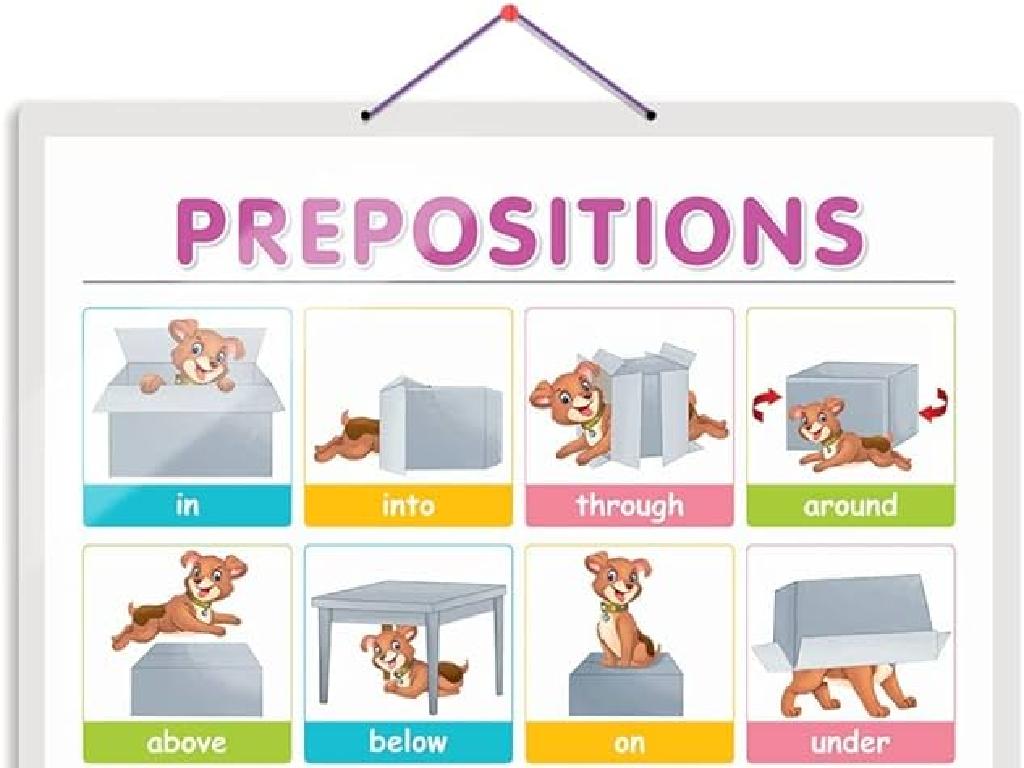Animal Cell Diagrams: Label Parts
Subject: Science
Grade: Seventh grade
Topic: Cells
Please LOG IN to download the presentation. Access is available to registered users only.
View More Content
Exploring Animal Cells: Life’s Building Blocks
– Cells: Life’s fundamental unit
All living organisms are composed of cells.
– Animal cells: Distinct features
Animal cells are eukaryotic with unique characteristics.
– Cell structure: Organelles’ roles
Organelles within cells have specific functions.
– Today’s task: Labeling cell parts
|
This slide introduces the concept of cells as the basic unit of life, setting the stage for a deeper dive into animal cells specifically. Emphasize that while all cells share common features, animal cells have distinct characteristics that differentiate them from plant cells, such as lacking a cell wall. Discuss the various organelles found in animal cells, such as the nucleus, mitochondria, and endoplasmic reticulum, and their roles in cell function. The activity for the day involves students labeling the parts of an animal cell diagram, reinforcing their understanding of cell structure. Provide clear diagrams and ensure students are familiar with the names and functions of each organelle. Encourage them to use the correct scientific terminology when labeling.
Exploring the Unit of Life: The Cell
– Define a biological cell
– The smallest unit of life, fundamental to all organisms.
– Cells as life’s building blocks
– Cells perform essential functions to sustain life.
– Compare animal and plant cells
– Animal cells lack a cell wall and chloroplasts unlike plant cells.
– Unique features of animal cells
– Animal cells have lysosomes and centrioles, which are not in plant cells.
|
This slide introduces the concept of a cell as the basic structural, functional, and biological unit of all living organisms. Emphasize the role of cells in carrying out life processes and maintaining homeostasis. Highlight the differences between animal and plant cells, such as the presence of a cell wall and chloroplasts in plant cells, which are absent in animal cells. Discuss the unique components of animal cells, like lysosomes involved in digestion and centrioles in cell division. Encourage students to think about how these differences affect the functions of each cell type. This foundational knowledge sets the stage for understanding more complex biological structures and systems.
Exploring the Animal Cell
– General structure overview
– Animal cells are eukaryotic with distinct organelles.
– Cell membrane, cytoplasm, nucleus
– The membrane is the boundary; cytoplasm fills the cell; the nucleus is the control center.
– Unique features of animal cells
– Unlike plant cells, animal cells do not have a cell wall or chloroplasts.
– Importance in biology
|
This slide introduces the basic structure and components of an animal cell, which is a fundamental topic in biology. The general structure includes the cell membrane, cytoplasm, and nucleus, each with specific functions. The cell membrane acts as a selective barrier, the cytoplasm houses organelles, and the nucleus contains genetic material. Highlight the differences between animal and plant cells, such as the lack of a cell wall in animal cells, which contributes to their flexibility. Emphasize the importance of understanding cell structure in the study of life sciences. Encourage students to observe diagrams and use models to visualize the components discussed. This foundational knowledge sets the stage for deeper exploration into cell functions and biology.
Exploring the Animal Cell
– Key parts of an animal cell
– Nucleus, Mitochondria, Ribosomes, and more
– Functions of each cell part
– Nucleus: controls cell; Mitochondria: energy production; Ribosomes: protein synthesis
– Synergy of cellular components
– All parts perform specific roles for cell survival
– Activity: Label a cell diagram
– Use a diagram to identify and label each part
|
This slide introduces students to the fundamental components of an animal cell, emphasizing the role each part plays in the cell’s overall function. The nucleus acts as the control center, the mitochondria provide energy, and ribosomes are responsible for protein synthesis. It’s crucial to convey how these parts are not isolated but work in concert to ensure the cell operates efficiently. The accompanying activity will help students apply their knowledge by labeling a cell diagram, reinforcing their understanding of each part’s location and function. Encourage students to use different colors for each cell part to enhance memorization and recognition.
The Nucleus: Command Center of the Cell
– Nucleus: The cell’s ‘Brain’
– The nucleus directs cell activities and contains genetic material.
– Structure of the nucleus
– Consists of a nuclear envelope, nucleoplasm, and nucleolus.
– Nucleus in cell reproduction
– Involved in mitosis, ensuring genetic information is passed on.
– Its role in cell function
– Regulates gene expression and maintains the integrity of genes.
|
The nucleus is often referred to as the ‘brain’ of the cell because it controls many functions, similar to how a brain controls an organism. It’s enclosed in a double membrane called the nuclear envelope and contains nucleoplasm, chromosomes, and the nucleolus. The nucleus plays a critical role in cell reproduction through the process of mitosis, ensuring that genetic information is accurately replicated and distributed to daughter cells. It also regulates gene expression, which is crucial for cell specialization and function. When discussing the nucleus, use diagrams to illustrate its structure and encourage students to label the different parts. Explain the importance of the nucleus in both cell reproduction and everyday cell function, providing a foundation for understanding more complex genetic concepts.
Mitochondria: The Cell’s Powerhouse
– Mitochondria as energy centers
– Often referred to as the ‘powerhouse’ of the cell.
– Energy production in mitochondria
– They convert nutrients into ATP, the cell’s energy currency.
– Role of energy in cellular functions
– Energy is crucial for movement, synthesis, and repair.
– Mitochondrial significance in metabolism
– Mitochondria play a key role in the cell’s metabolism.
|
This slide focuses on the mitochondria, which are vital organelles within animal cells responsible for generating energy. Students should understand that mitochondria are where respiration happens, converting glucose and oxygen into adenosine triphosphate (ATP), which is used by the cell to power various activities. Emphasize the importance of energy in supporting cell functions such as muscle contraction, protein synthesis, and cell division. Discuss how mitochondrial dysfunction can affect overall metabolism and lead to various diseases. Encourage students to think of mitochondria as the cell’s power plants, providing the energy needed for all cellular operations.
Cell Membrane: Protection and Communication
– Cell membrane as a protector
– Communication via cell membrane
– Acts as a gatekeeper, controlling entry and exit of substances
– Significance of selective permeability
– Allows some substances in while keeping others out, maintaining homeostasis
– Transport roles of the membrane
|
The cell membrane is crucial for maintaining the integrity of the cell, acting as a barrier that protects cellular contents. It also plays a vital role in communication between cells and their environment, facilitating the transport of materials necessary for cell survival. Selective permeability is a key feature, allowing the cell to regulate its internal conditions by controlling the movement of substances across the membrane. This concept is fundamental for students to understand as it underpins many cellular processes. During the lesson, use diagrams to illustrate how the cell membrane functions and provide examples of substances that can and cannot pass through the membrane easily.
Labeling the Animal Cell
– Engage in an interactive labeling activity
– Identify each part of an animal cell
– Find structures like the nucleus, mitochondria, etc.
– Learn the location and function
– Understand where each part is and what it does
– Discuss the role of each cell component
– How does each part contribute to the cell’s life?
|
This slide introduces an interactive class activity focused on labeling the parts of an animal cell. Students will identify and label various cell components such as the nucleus, mitochondria, endoplasmic reticulum, and more. The activity is designed to help students visualize the cell structure and understand the specific function of each part. Teachers should prepare cell diagrams for labeling, and guide students through the activity, ensuring they grasp the location and role of each component. After labeling, a discussion can be facilitated to deepen understanding of how each part contributes to the overall functioning of the cell. Possible activities include creating a 3D cell model, drawing diagrams from memory, or matching functions to cell parts.
Class Activity: Create Your Own Cell Model
– Gather materials: Playdough, beads, string, labels
– Construct a 3D animal cell model
Use playdough to form the cell body, beads for organelles
– Label each cell part accurately
Attach labels to the corresponding cell parts
– Discuss the function of each part
Share what each part does after labeling
|
This hands-on activity is designed to help students understand the structure of an animal cell by creating a 3D model. Provide students with playdough to represent the cytoplasm, various beads to symbolize organelles like the nucleus, mitochondria, and ribosomes, string for the endoplasmic reticulum, and labels for each part. Students should mold the playdough into the shape of a cell, place the beads to represent organelles, and use the string to create the endoplasmic reticulum. Once the model is assembled, students will label each part and discuss its function in the cell. This activity will reinforce their understanding of cell anatomy and the role of each organelle. Possible variations of the activity could include using different materials for organelles, creating a cell poster instead of a model, or comparing animal cells to plant cells.
Review: Animal Cell Components
– Recap main parts of an animal cell
– Open floor for student questions
– Discuss each part’s importance
– For example, the nucleus is the control center, directing cell activities.
– Relate cell parts to cell life
– Like organs in a body, each part has a unique and crucial role.
|
Begin the slide by quickly reviewing the main parts of an animal cell, such as the nucleus, mitochondria, cell membrane, and others. Allow students to ask any lingering questions they might have about the cell parts or their functions. After addressing questions, discuss the importance of each cell part, likening them to the organs in a body, each with a specific role that contributes to the overall life and health of the cell. Emphasize how these components work together to ensure the cell’s survival, growth, and reproduction. This discussion will help students appreciate the complexity and efficiency of living cells.
Homework: Mastering Animal Cell Structure
– Draw an animal cell from memory
– Label each part of the cell
– Describe functions of two cell parts
– Choose any two, like the nucleus (controls cell activities) or mitochondria (powerhouse of the cell)
– Study for a quiz on cell parts
– Review all cell parts and their functions
|
This homework assignment is designed to reinforce the students’ understanding of the animal cell structure and its components. By drawing and labeling the cell from memory, students will actively engage with the material, enhancing retention. Encouraging them to write about the functions of two cell parts helps them to not only memorize the parts but also understand their roles within the cell. The upcoming quiz will motivate them to review and study the cell parts thoroughly. Provide tips on how to effectively study, such as using flashcards or creating a study group. Remind students that understanding the cell is fundamental to all biology and will be applicable in future lessons.






